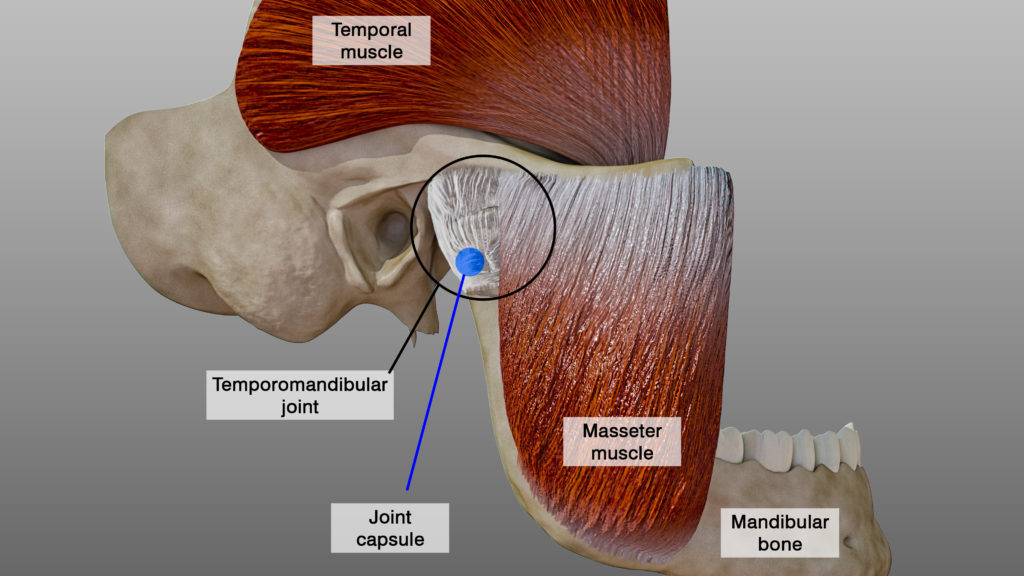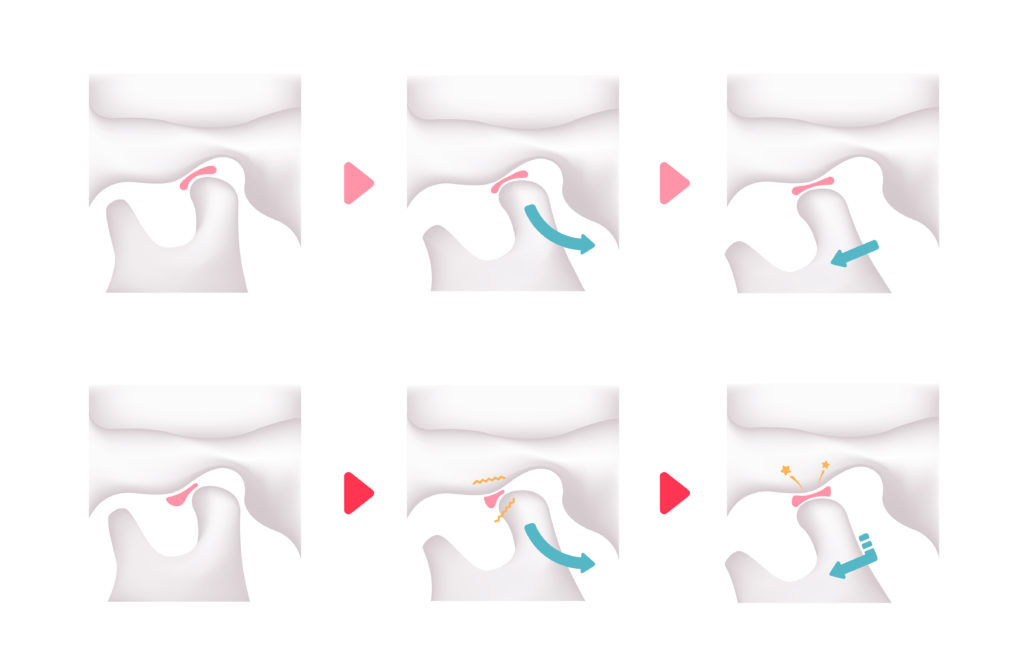Jaw tension seems as ubiquitous as liking puppies or dreading Mondays. If I asked a stadium full of people whether they’ve ever experienced jaw tightness, I’d be willing to bet that the majority of the crowd would raise their hand.
According to a recent study, 11-12 million adults in the United States had pain in the region of the temporomandibular joints (the pair of joints that attaches your mandible, or jaw bone, to your skull). While jaw tightness doesn’t necessarily mean a temporomandibular disorder (TMD) is imminent, it can be an early symptom and should be treated with care.
Unfortunately, there is no clear reason why jaw tightness seems to be more prominent among certain groups of people over others. According to this same study, TMDs are twice as common in women as they are in men, especially women between the ages of 35-44. So while you can’t create a concrete list of activities and practices to avoid, there are still dependable methods for alleviating jaw tension.

Before diving into these simple tips, you’ll want to get acquainted with the design of the jaw to help put these tips into context.
Design of the Jaw
The jaw is composed of a single large bone called the mandible, which attaches to the bottom of the skull via two temporomandibular joints. These two joints are unique in that they:
- Function as a single unit to move the mandible up and down, side to side, forward, and back.
- Allow for a compound movement of the jaw – hingeing and sliding.
The four main muscles responsible for moving the mandible are the temporalis, the masseter, the medial pterygoid, and the lateral pterygoid. Together, these muscles enable the act of chewing or mastication. The masseter is one of the strongest muscles in the body, and when working together, these four muscles make an extraordinarily powerful team.
(If you’re a visual learner and want to explore more, I highly recommend checking out The Anatomy Coloring Book by Wynn Kapit and Lawrence M. Elson. The illustrations in this book help you conceptualize both the boney structure and the musculature of the jaw.)
The resting position of the jaw, or more specifically the temporomandibular joints, is not with teeth touching but rather with approximately 2-4 millimeters of clearance between the top and bottom teeth. Did you just unclench your teeth after reading this sentence? You’re not alone!
With this design information in mind, here are three simple tips for relieving jaw tightness that have proven to be game-changers.
Tip 1 – Check-In With Your Alignment
The body is beautifully designed to facilitate optimal, efficient movement. However, as you grow up, your body picks up new habitual movement patterns based on your everyday experiences that can cause you to lose that sense of balance and coordination. The good news is that, oftentimes, all it takes to recalibrate your alignment is just bringing more awareness to your daily movement patterns.
Do you use one of those apps that remind you to drink water throughout your day? You can think of this first tip as a similar form of habitual implementation.

Set reminders to regularly check in with your alignment, specifically for noticing the position of your jaw. If you notice tightness, simply remind yourself to release your jaw and glide down to its optimal resting position as it’s designed to do.
Continue this throughout your day. You may notice more jaw tightness during certain parts of your day, such as when sitting at your desk or when engaging in conversation with certain individuals. You will likely begin to notice patterns and pick up valuable information for embodying more suppleness around your jaw.
Tip 2 – Ask For an Open Airway
Sometimes all it takes to alleviate tightness around the jaw is to release any tightness or gripping in the surrounding areas. One common contributor to jaw tightness is the airway, or more specifically, the position of the glottis (the opening between the vocal folds). As a little experiment, take a moment to notice the state of your glottis at this moment.
Is it open? Closed? Held in a static position?
If you noticed yourself using your laryngeal muscles to hold your glottis closed between inhales and exhales, try going through a few cycles of breath while continuously asking for your glottis to fall open. Think of your breath forming a circle or oval so that there’s no break between inhales and exhales. After a few iterations, you may find your jaw begin to release as some of the muscles of the throat release as well.
Tip 3 – Hum
As a professional singer and voice coach, you could say I’m hyperaware of the state of my jaw as it plays an active role in my ability to use my voice efficiently and sustainably. So it may come as no surprise that vocalization is one of my game-changing tips for alleviating jaw tightness. — and, don’t worry, no singing experience is needed in order to reap the benefits of this exercise:
My “Ng-hum → Ah” Vocal Exercise:
Starting with an “ng” hum on a comfortable pitch (otherwise known as an open-mouth or nasal hum), gradually lower the back of your tongue as you continue phonating to create an “ah” vowel.
Then, slide back and forth between the hum and the “ah,” noticing the movement of your jaw. If you noticed your jaw drop as you open to the “ah,” try experimenting with initiating your hum with that same release as you achieve with your “ah” so that the only articulator moving throughout the entire exercise is your tongue.
Once you feel comfortable with this exercise, try taking things one step further by sliding up and down a few pitches as you glide from the hum to “ah.”

Interestingly, the benefits of humming travel far beyond directly alleviating jaw tightness, including lowering blood pressure and stress-related hormones as well as releasing endorphins and oxytocin. To be honest, I felt my jaw release just considering the impact of these perks.
With these simple tips in mind, I hope you’re not only able to find some instantaneous relief to any jaw tightness you may be experiencing currently but also initiate more curiosity around how your daily habits impact the position of your jaw and vice versa.
If you found these tips helpful, I have a feeling you might also benefit from these tips for alleviating pain from slouching in front of your computer.
Now go forth with renewed suppleness and ease.
Sources
TMD (Temporomandibular Disorder). (2022, January). National Institute of Dental and Craniofacial Research. https://www.nidcr.nih.gov/health-info/tmd
Smith, C. (2014). Learn Muscle Anatomy: Muscles of Mastication. Visible Body. https://www.visiblebody.com/blog/learn-muscle-anatomy-muscles-of-mastication
Kapit, W. & Elson, L. M. (2013). The Anatomy Coloring Book 4th Edition. Pearson; 4th Edition. https://www.amazon.com/Anatomy-Coloring-Book-Wynn-Kapit/dp/0321832019
Glottis-Structure and Function. (2022). Get Body Smart. https://www.getbodysmart.com/larynx/glottis
Goldman, J. & Goldman, A. (2017). 7 Reasons for Humming. Jonathan Goldman’s Healing Sounds. https://www.healingsounds.com/7-reasons-for-humming/
Ippolito, H. S. (2021). Endless Hours of Slouching on Zoom Calls Causing You Pain? These 5 Simple Steps Are Your Answer? The Maps Institute. https://themapsinstitute.com/endless-hours-of-slouching-on-zoom-calls-causing-you-pain-these-5-simple-steps-are-your-answer/
